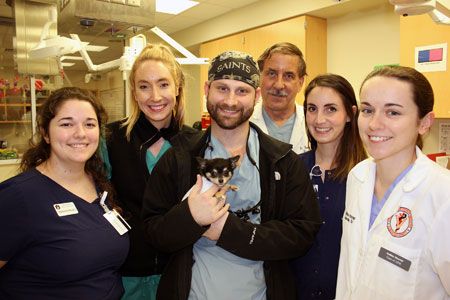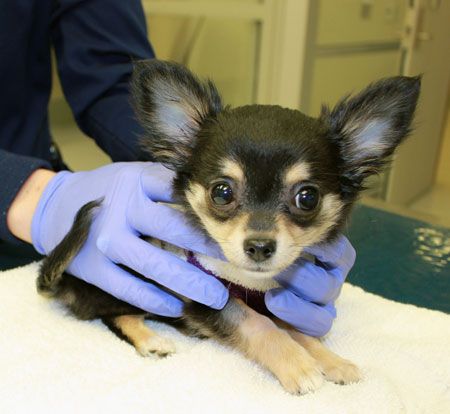Chihuahua becomes Auburn's smallest PDA patient
After a successful, albeit challenging, patent ductus arteriosus procedure, a 3-month-old, 2-lb Chihuahua is believed to be Auburn's smallest veterinary patient to undergo the surgery to date.

The surgery team included, from left, anesthesia technician Madeline Murphy; fourth-year veterinary student Halle Thomasch; surgical resident Dr. Christopher Lee; soft tissue surgeon Dr. Harry Boothe; Soft Tissue Service surgery technician Haley Pritchard; and fourth-year veterinary student Andrea Hoover. Dr. Jacob Johnson, not pictured, served as anesthesiologist. Photo courtesy of Auburn College of Veterinary MedicineA 3-month-old longhaired Chihuahua weighing less than 2 pounds recently became Auburn College of Veterinary Medicine's smallest patient to undergo patent ductus arteriosus (PDA) surgery, according to an Auburn release. After being referred from her Seattle-based primary care veterinarian, Luna, escorted by her owner, Jennifer Glover, came to Auburn.
Glover explains that Luna was diagnosed in January. “I initially noticed that she had a persistent, hacking cough,” she says in the release. “This was at nine-and-a-half weeks old, so I took her to our vet and he detected a heart murmur.”
While it occurs in about 3,000 newborn human babies each year in the United States, PDA is also common in dogs, the release states-clinicians and staff at Auburn's Wilford and Kate Bailey Small Animal Teaching Hospital treat a number of patients for it annually.
At 1.76 pounds, though, Luna became a special case and had to be treated differently to compensate for her size, explains Harry Boothe, DVM, MS, DACVS, a professor of soft tissue surgery who led the surgery team. “Surgery in small, young patients is a challenge from both an anesthetic and surgical perspective,” he says in the release.
Luna's small size came with challenges the surgical team doesn't normally face. “Her thoracotomy necessitated placing her on a ventilator during the surgical procedure,” Dr. Boothe explains. “Specific challenges included minimizing hypothermia, avoiding hypoglycemia and gaining access to the heart and abnormal vasculature.”

Luna, Auburn's smallest PDA patient in question. Photo courtesy of Auburn College of Veterinary Medicine Still, Dr. Booth says the procedure required very few special procedures or techniques despite Luna's size: “The exception [was] that a retractor that is typically used to separate the eyelids in horses was used to separate Luna's ribs during the procedure. A standard rib retractor would have been much too large to use in this situation. The overall procedure for performing the surgery was essentially the same as any other patent ductus arteriosus ligation surgery; the scale was just smaller.”
Finding a team willing to perform the surgery in the first place was a challenge as well. “I met with a veterinary cardiologist in Seattle,” Glover says, “but because Luna is so small, he was reluctant to do the procedure. We began researching veterinary hospitals where this procedure had been performed successfully and often, and we found Auburn.”
Dr. Boothe says Luna was extremely small even compared to case studies nationally. Information cited in a large retrospective study of dogs with PDA (more than 500 cases) published in 2014 listed their smallest patient being 1.8 kg and their youngest patient being 3.3 months. In comparison, Luna weighed 0.8 kg and was 2.8 months old at the time of her surgery.
After a postsurgical examination and evaluation, Luna received a clean bill of health and was discharged February 12, the release states. The medical team recommended that Luna be evaluated by her primary veterinarian in six months, but added that the tiny Chihuahua should recover completely from the condition and live a normal, healthy life.